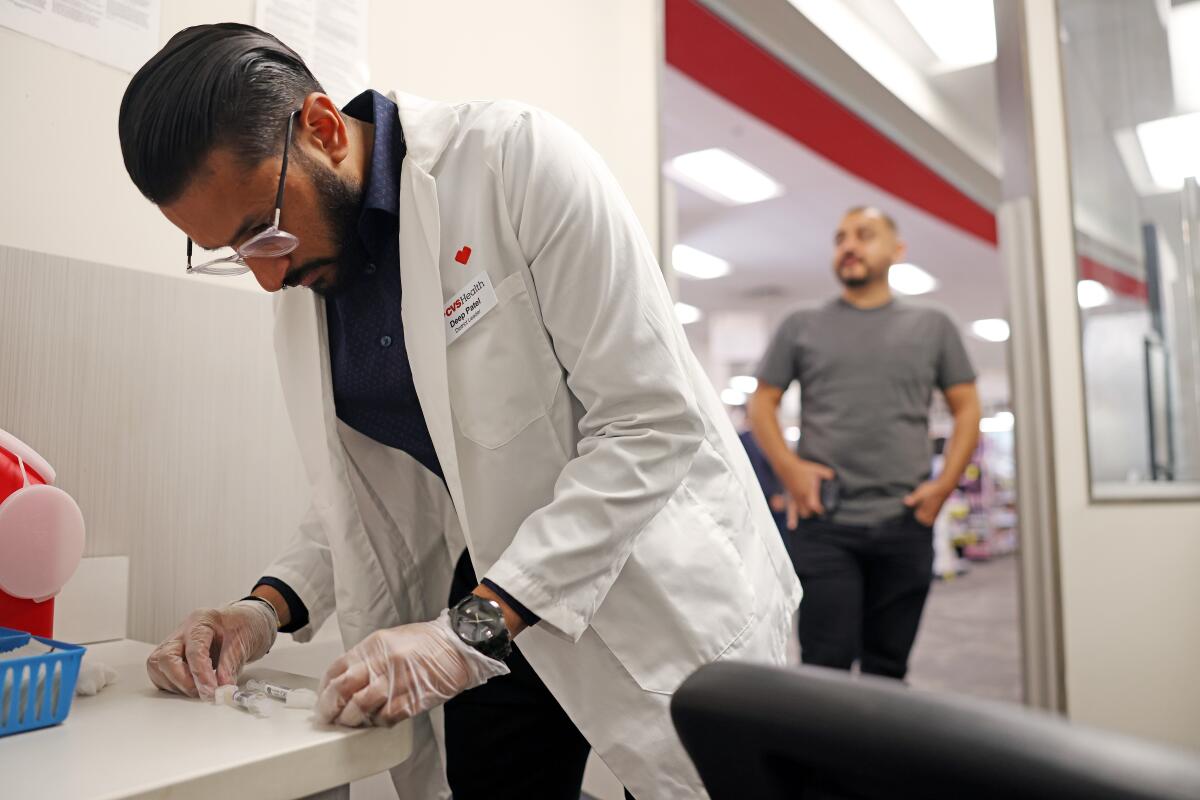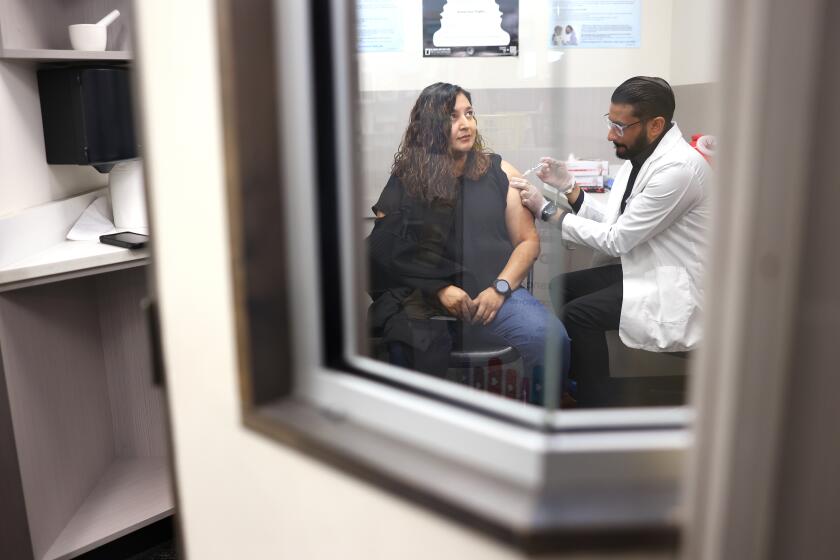An even more contagious COVID strain is ‘just getting started’ amid California wave

The summer surge of the coronavirus subvariants nicknamed FLiRT has given way to ever more contagious strains, a key reason behind the current high levels of COVID in California and nationwide.
And doctors and scientists are keeping an eye on yet another subvariant — XEC — that could surpass the latest hyperinfectious subvariant, KP.3.1.1, now thought to be the most common nationwide. XEC was first detected in Germany and has since seized the attention of doctors and scientists worldwide.
XEC “is just getting started now around the world and here,” said Dr. Eric Topol, director of the Scripps Research Translational Institute in La Jolla. “And that’s going to take many weeks, a couple months, before it really takes hold and starts to cause a wave.˜
“XEC is definitely taking charge. ... That does appear to be the next variant,” Topol added. “But it’s months off from getting into high levels.”
While XEC has shown up in the United States, its prevalence is low and it is not being individually tracked on the U.S. Centers for Disease Control and Prevention’s variant tracker website. A lineage must be estimated to circulate above 1% nationally over a two-week period for it to be tracked.
COVID cases and hospitalizations rise in L.A. County — and some of those recently reinfected with the FLiRT variants are finding the latest bout the worst yet.
The expected midyear wave began in May, when the winter’s dominant subvariant, JN.1, gave way to a number of subvariants nicknamed FLiRT — a cheeky name based on the letters of two key mutations, F456L and R346T, Topol said. (Focus only on the letters and add an “i” as a connector, and you get FLiRT, which includes the officially named KP.2 subvariant.)
Then, “the FLiRT eventually gave way to new variants that had even more growth advantage,” Topol said.
A successor subvariant, KP.3, had a different mutation — Q493E — and dropped R346T. It was nicknamed FLuQE, pronounced “fluke.” And an even more contagious subvariant — KP.3.1.1 — had a mutation that was deleted, giving it the unofficial moniker deFLuQE, or “de-fluke.”
The “S31 deletion,” Topol said, is “what’s made that a kind of very pathogenic, very immune evasive variant. That S31 deletion has been studied — particularly by the Sato lab in Japan — and that’s the culprit that’s making this wave prolonged and getting into a lot of people who otherwise might have ... not gotten sick.”
“The KP.3.1.1 is definitely an outlier for growth advantage,” he added. “It’s not over yet, obviously. And we’re going to have new variants beyond KP.3.1.1.”
With COVID numbers in California spiking this summer, experts are warning the new FLiRT strains driving the spread could be around for some time.
KP.3.1.1 is still estimated to be the nation’s most common subvariant. For the two-week period that began Aug. 18, KP.3.1.1 was estimated to make up 42.2% of coronavirus samples nationwide, up from 19.8% a month ago, according to the CDC.
The Moderna and Pfizer vaccines that just came out just before the Labor Day weekend are designed against KP.2, a predecessor of KP.3.1.1, so they are a relatively close match for the main circulating variants. XEC, however, won’t be as closely aligned.
The new vaccines are still way better for the current season compared to the shot released a year ago, which targeted XBB.1.5, but the difference between what the latest vaccine is designed against and XEC, is “pretty substantial ... and we’ll see how it plays out,” Topol said.
“It would be surprising if this doesn’t turn out to be the next challenge,” Topol said. Still, “any booster will help induce a higher level of immunity.”
Dr. Elizabeth Hudson, regional chief of infectious diseases for Kaiser Permanente Southern California, said she thought the new vaccines would still provide some good protection against XEC “because there is some overlap, because these are all sub, sub, sub-grandchildren of the original Omicron. So there is still going to be some level of protection there.”
“We’re not like in a new Greek letter — they’re not that much different; it’s not like something completely new,” Hudson said.
XEC is a recombination of two different, little-discussed subvariants: KS.1.1 and KP.3.3, Hudson said. “It’s definitely one that I have my eye on,” she said.
“But this is a little bit different, and it does seem to be showing what we call a growth advantage over the JN.1, or the deFLuQE variants, or the FLiRT variants,” Hudson said.
“It’s going to be a little hard to know where this is going to go, because right now, KP.3.1.1 really still is the predominant variant,” Hudson said. “So we have to really monitor not only what’s happening within the U.S., but also what’s happening in Europe as they get more towards their colder seasons.”
The CDC says September and October are generally the best times for most people to get a COVID shot, though there are other factors to consider.
Besides Germany, XEC has been reported elsewhere in western Europe, including the Netherlands, and has spread relatively quickly, Hudson said.
“We’ll really have to watch — because the overall info on it is not super robust now — but I would imagine over the next couple of weeks, particularly if it starts to creep up higher and higher, we will be hearing a little bit more about it,” Hudson said.
COVID has proved to be far more wily than the flu. Instead of one fall-and-winter wave, as flu typically delivers, COVID seems to bring two waves each year.
There are several reasons for that difference. “One is that the virus keeps evolving, and it takes that long for a variant to really pick up steam and to become dominant,” Topol said.
The second is that our immunity — at least in terms of infection — is short-lived, allowing many who recover in the winter to get COVID again in the summer, Topol said. (Luckily, protection against hospitalization and death has been more durable, explaining why hospitals are no longer strained despite high levels of coronavirus circulating nationwide.)
And finally, few people are adhering to precautionary measures that were far more common years ago, Topol said. Fewer people are wearing masks in crowded indoor settings, staying up to date on their vaccinations or even staying home when sick.
As of spring, 22.5% of U.S. adults and 29.1% of a subset of seniors 65 and older got the COVID-19 vaccination for the 2023–24 season. Vaccination rates were higher for the flu, estimated to cover 48.5% of adults and 50.6% of seniors.
In California as of July 31, 37% of seniors had received the updated COVID-19 vaccine for the 2023–24 season, as did 18.7% of those age 50 to 64, and 10.1% of the youngest adults.
More to Read
Sign up for Essential California
The most important California stories and recommendations in your inbox every morning.
You may occasionally receive promotional content from the Los Angeles Times.














